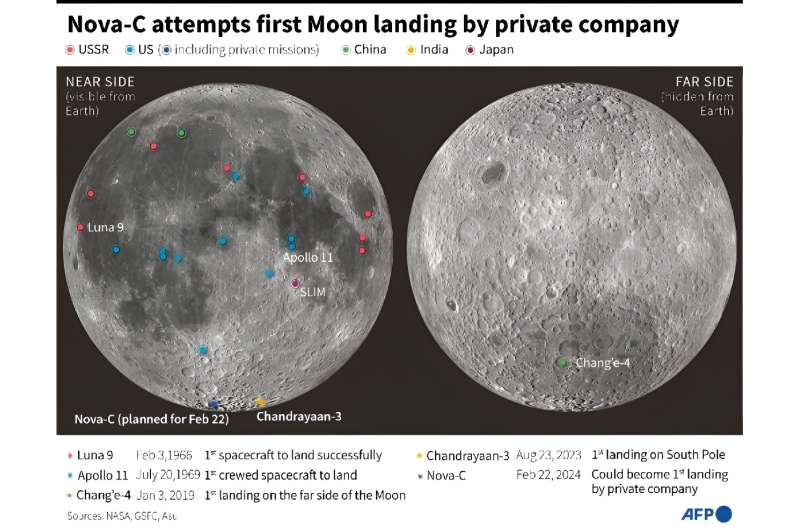For the first time since the Apollo era, an American spaceship has landed on the Moon: an uncrewed commercial robot, funded by NASA to pave the way for US astronauts to return to Earth’s cosmic neighbor later this decade.
Odysseus, built by Houston-based Intuitive Machines, touched down near the lunar south pole Thursday at 2323 GMT, after a nail-biting final descent where flight controllers had to switch to an experimental landing system and took several minutes to establish radio contact with the lander after it came to rest.
“Today for the first time in more than a half century, the US has returned to the Moon,” NASA administrator Bill Nelson said in a video. “Today for the first time in the history of humanity, a commercial company, an American company, launched and led the voyage up there.”
Images from an external “EagleCam” designed to shoot out from the spacecraft during its final seconds of descent could be released early Friday, a member of the team that built it told AFP.
“After troubleshooting communications, flight controllers have confirmed Odysseus is upright and starting to send data,” Intuitive Machines said in its latest update on X.
“Right now, we are working to downlink the first images from the lunar surface.”
A previous moonshot by another American company last month ended in failure, raising the stakes to demonstrate that private industry had what it took to repeat a feat last achieved by US space agency NASA during its manned Apollo 17 mission in 1972.

Landing sites for spacecraft on the Moon.
Lunar south pole
Underscoring the technical challenges, an onboard navigation system failed and Odysseus instead flew the final leg of its trip using an experimental laser guidance system developed by NASA to run only as a technology demonstration.
Confirmation of landing was supposed to come seconds after the milestone, but instead nearly 15 minutes passed as announcers mused whether the craft had come down “off angle.”
Finally, the company’s chief technology officer Tim Crain confirmed “our equipment is on the surface of the Moon and we are transmitting,” as applause broke out in mission control.
Odysseus touched down in Malapert A, an impact crater 300 kilometers (180 miles) from the lunar south pole.
NASA hopes to eventually build a long-term presence and harvest polar ice for both drinking water and rocket fuel for an onward journey to Mars under Artemis, its flagship program.

This photo courtesy of Intuitive Machine shows the first view of Earth taken during the IM-1 mission.
The current mission is “one of the first forays into the south pole to actually look at the environmental conditions to a place we’re going to be sending our astronauts in the future,” said senior NASA official Joel Kearns.
NASA’s first crewed mission to the region is scheduled for no sooner than 2026. America’s geopolitical rival China is also planning to send its first crew to the Moon in 2030, ushering in a new era of space competition.
Exclusive club
Hexagon-shaped Odysseus, which is about the size of a large golf cart, launched from Florida on February 15 on a SpaceX Falcon 9 rocket, boasting a new liquid methane, liquid oxygen propulsion system that traversed the quarter million mile voyage in quick time.
It carries six NASA science instruments, including cameras to investigate how the lunar surface changes as a result of the engine plume from a spaceship, and a device to analyze clouds of charged dust particles that hang over the surface at twilight as a result of solar radiation.
The rest of the cargo was shipped on behalf of Intuitive Machines’ private clients, and includes 125 stainless steel mini Moons by the artist Jeff Koons.

Graphic of the Odysseus Nova-C class lander by US company Intuitive Machines, part of NASA’s Artemis project to bring humans back to the Moon and build a permanent base there.
The cargo can run for up to seven days before lunar night occurs, rendering Odysseus inoperable.
NASA paid Intuitive Machines $118 million to ship its hardware under a new initiative called Commercial Lunar Payload Services (CLPS), which it created to delegate cargo services to the private sector to achieve savings and stimulate a wider lunar economy.
The first CLPS mission, by Pittsburgh-based Astrobotic, launched in January, but its Peregrine spacecraft sprung a fuel leak and was eventually brought back to burn up in Earth’s atmosphere.
Spaceships landing on the Moon must navigate treacherous terrain and rely on thrusters to control their descent in the absence of an atmosphere.
Until now, only the space agencies of the Soviet Union, United States, China, India and Japan had accomplished the feat, making for an exclusive club.
2024 AFP
Citation:
America returns spaceship to the Moon, a private sector first (2024, February 23)



